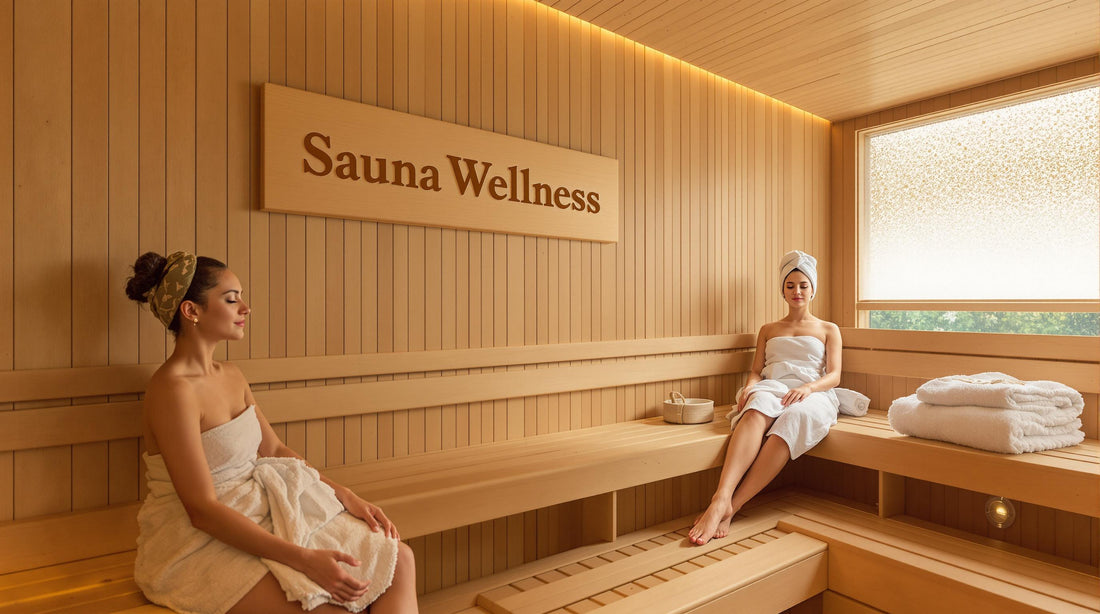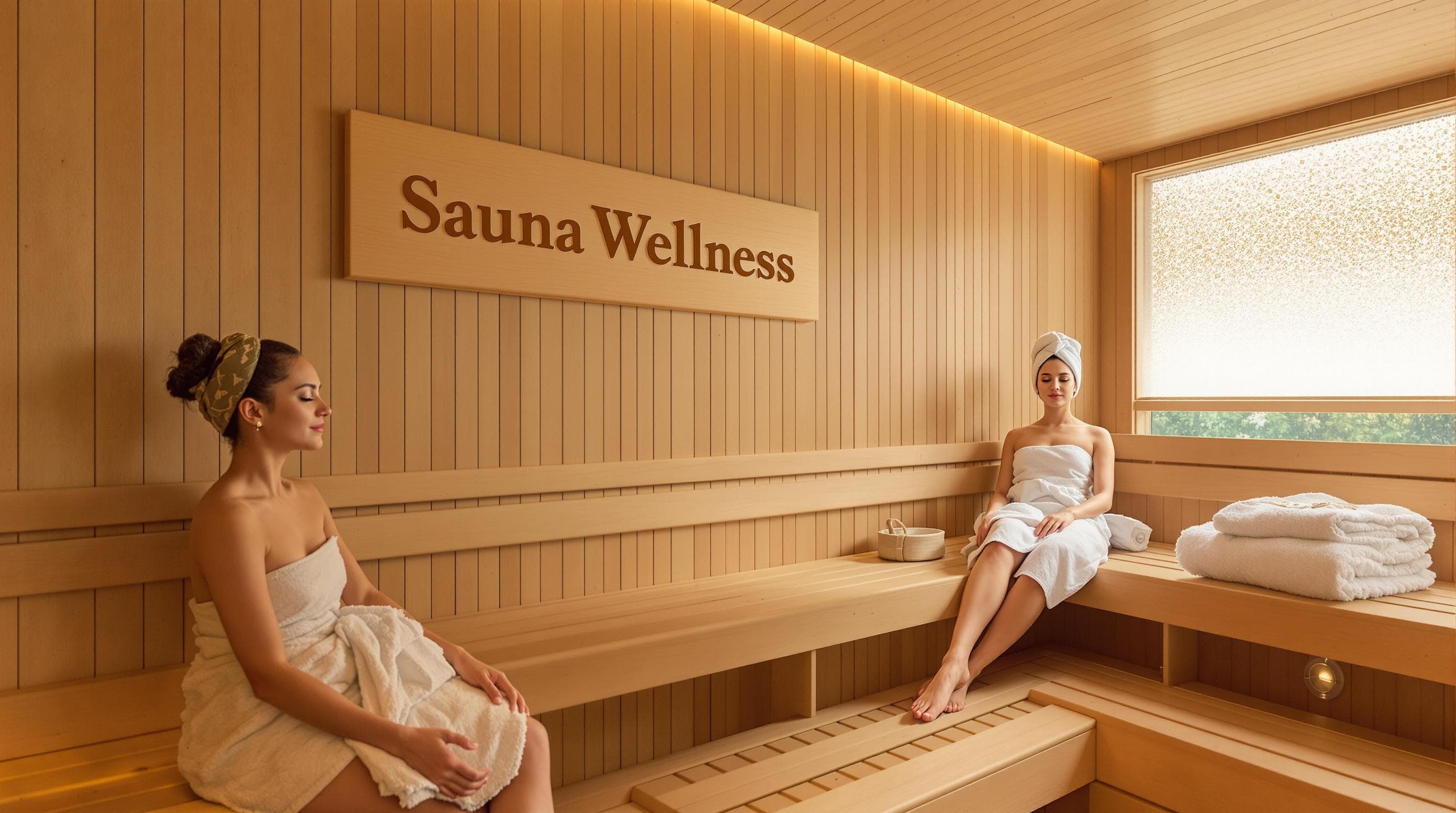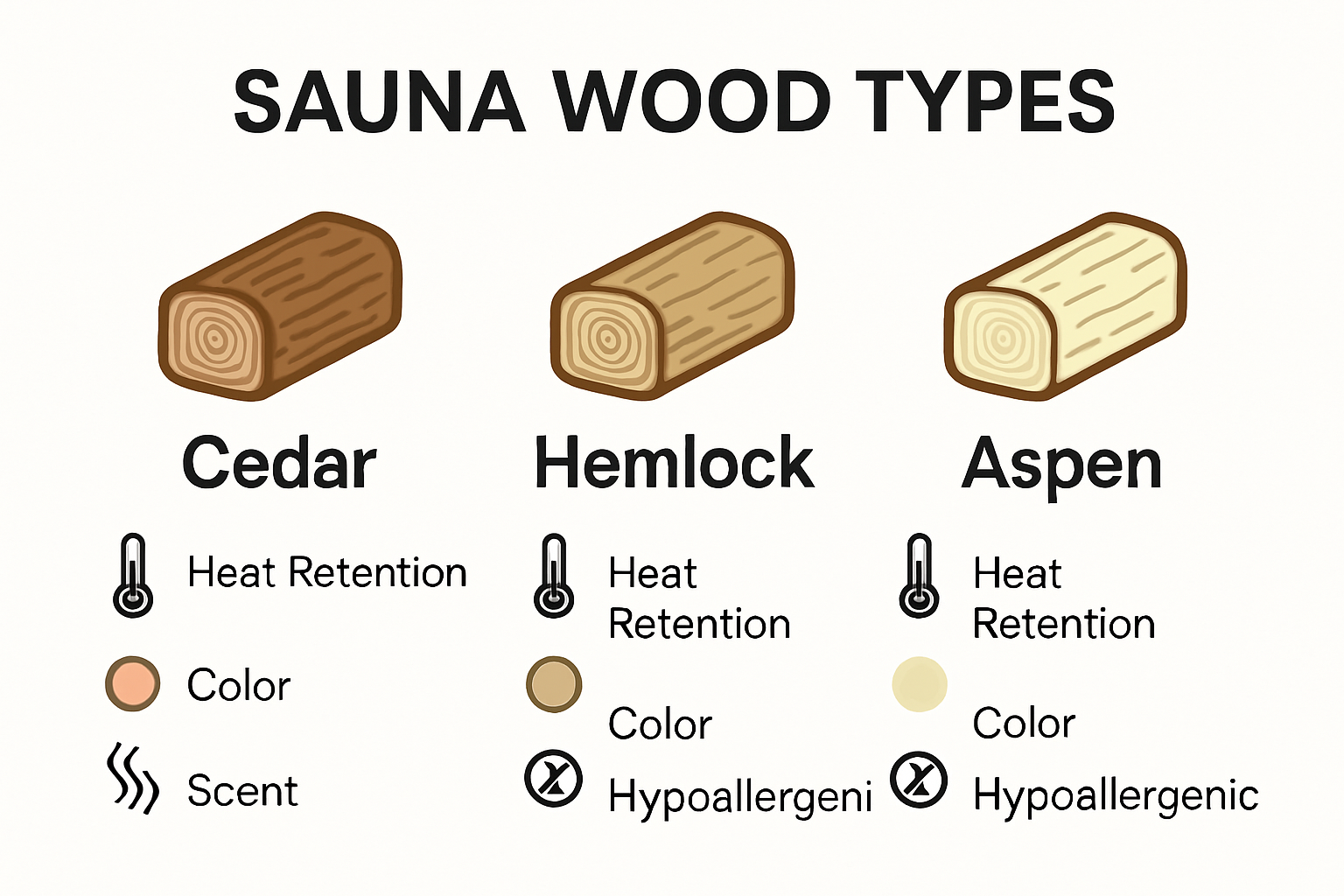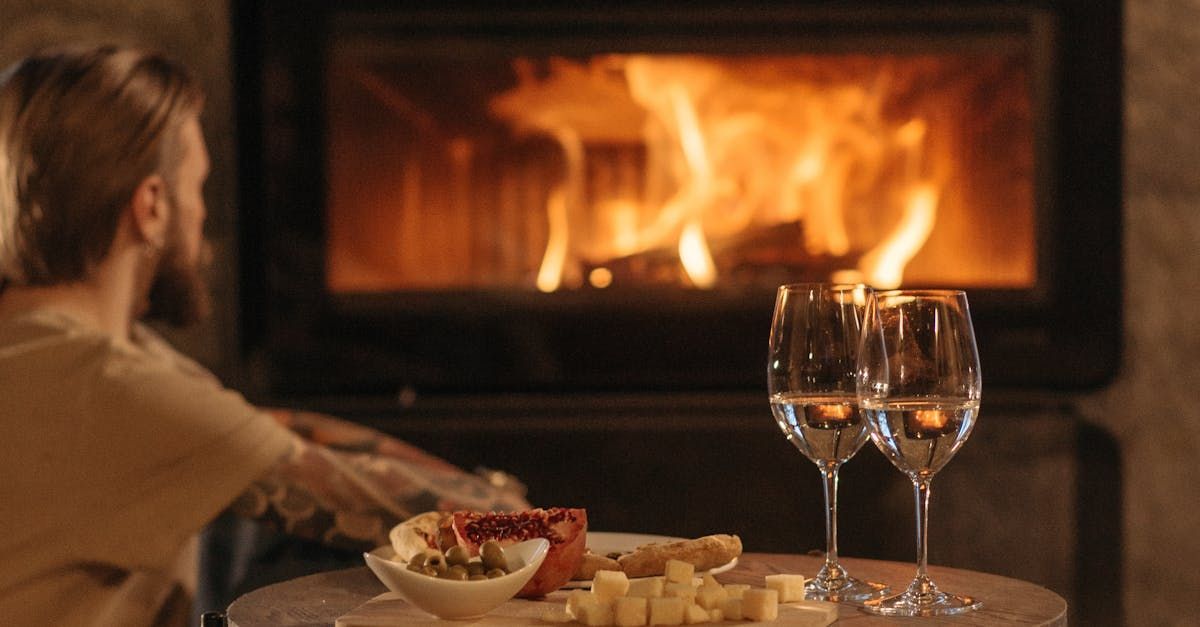
Decorating Your Sauna: Inspiring Ideas for Wellness in 2025

Decorating a sauna in 2025 is about more than just picking pretty wood panels. Here is a surprising fact: the global sauna accessories market is expected to grow at an impressive 7 percent annual rate through 2030. But those trendy accessories are not what really transform your space. The real secret lies in unexpected details like color psychology and ergonomic design, which can turn any sauna into a true wellness sanctuary tailored to your unique needs.
Table of Contents
- Choosing The Best Materials And Colors
- Lighting Solutions For A Relaxing Atmosphere
- Adding Wellness Touches And Accessories
- Maximizing Comfort And Functionality
Quick Summary
| Takeaway | Explanation |
|---|---|
| Natural Wood Matters | Choosing the right wood, such as cedar for heat retention or aspen for a calming effect, significantly impacts sauna thermal comfort and overall experience. |
| Lighting Enhances Relaxation | Utilizing warm color temperatures and innovative lighting solutions like chromotherapy can create a soothing sauna environment that promotes relaxation and stress relief. |
| Invest in Wellness Accessories | Incorporating essential accessories, such as hygrometers and essential oil diffusers, maximizes comfort and enhances the holistic health benefits of sauna sessions. |
| Prioritize Ergonomic Design | Implementing ergonomic layouts and proper ventilation systems can significantly improve comfort and functionality, making sauna use more enjoyable and beneficial. |
Choosing the Best Materials and Colors
Creating a visually appealing and functionally superior sauna requires thoughtful selection of materials and colors that enhance both aesthetic and wellness experiences. The right choices can transform your sauna from a simple heat room to a personal sanctuary of relaxation and rejuvenation.
Natural Wood Selection for Optimal Sauna Environments
Wood selection plays a critical role in decorating your sauna, with each type offering unique characteristics that impact thermal comfort and overall experience. Research from wood science experts reveals fascinating insights into how wood color and type influence thermal perceptions.
Cedar stands out as a premier choice, renowned for its exceptional heat retention and natural resistance to decay. Its rich, warm tones create an inviting atmosphere while providing practical benefits. Aspen emerges as another excellent option, offering a light color palette that creates a calming and serene environment. Basswood presents a hypoallergenic alternative with a gentle, soothing aroma that contributes to relaxation.
Interestingly, wood color significantly impacts thermal comfort. Yellow-white wood walls provide superior thermal comfort at lower temperatures, while brown wood surfaces feel more comfortable at higher heat levels. This scientific understanding allows you to strategically choose wood types that optimize your sauna experience.
Here is a table summarizing the most common sauna woods and their unique benefits for wellness and thermal comfort:
| Wood Type | Key Characteristics | Wellness Benefits | Thermal Comfort Impact |
|---|---|---|---|
| Cedar | High heat retention, decay-resistant, rich aroma | Inviting atmosphere, natural resistance to decay, aromatic relaxation | Comfortable at various temps, effective heat retention |
| Aspen | Light color, hypoallergenic, smooth texture | Calming, gentle feel, suitable for sensitive individuals | Feels cooler, calming at lower temps |
| Basswood | Hypoallergenic, soft aroma, pale appearance | Relaxing, anti-allergenic, understated look | Gentle heat, doesn’t overheat |
| Brown woods (general) | Deeper color shades | Coziness, intimacy | Best for higher heat settings |
| Yellow-white woods (general) | Bright appearance | Openness, serenity | More comfortable at lower temperatures |

Sustainable and Eco-Friendly Material Considerations
Modern sauna design goes beyond aesthetic appeal, embracing environmental responsibility. Sustainable design research highlights the importance of selecting materials that support both personal wellness and ecological consciousness.
Reclaimed wood offers an excellent solution for environmentally conscious sauna enthusiasts. These materials not only reduce environmental impact but also bring unique character and history to your space. Eco-friendly insulation materials further enhance the sustainability of your sauna, creating a holistic wellness environment that supports both personal and planetary health.
Color Psychology and Thermal Design
Color selection in sauna design extends far beyond mere visual appeal. Different colors can profoundly impact mood, perception of temperature, and overall relaxation experience. Warm earth tones like soft browns, muted oranges, and gentle terracotta colors create a sense of grounding and comfort. Cool blues and greens can introduce a calming element, mimicking natural landscapes and promoting mental tranquility.
Consider incorporating accent walls or subtle color gradients that complement the natural wood tones. Lighter colors can make the space feel more open and airy, while deeper tones create a sense of intimacy and warmth. The key is finding a balance that resonates with your personal aesthetic and promotes a sense of well-being.
By carefully selecting materials and colors, you transform your sauna from a simple room into a personalized wellness sanctuary. Each choice becomes an intentional step towards creating a space that nurtures both body and mind, reflecting your unique approach to health and relaxation.
Lighting Solutions for a Relaxing Atmosphere
Lighting transforms a sauna from a simple heated space into a sanctuary of wellness and tranquility. Strategic illumination not only enhances visual appeal but also significantly influences psychological and physiological relaxation responses. Understanding the nuanced role of lighting becomes crucial in creating an immersive and therapeutic sauna experience.
Color Temperature and Emotional Wellness
Scientific research from medical psychology reveals the profound impact of lighting color temperatures on human emotional states. Warm-toned lighting between 2700K and 3000K creates a soothing environment that promotes relaxation and reduces stress. These soft, amber-like hues mimic natural sunset colors, signaling to the body that it is time to unwind and release tension.
Conversely, cooler light temperatures around 4000K can increase arousal levels and mental alertness. For sauna environments designed for deep relaxation, selecting warmer color spectrums becomes essential. Strategically placed warm lights can help lower cortisol levels and encourage a meditative state, transforming your sauna into a personal rejuvenation zone.
Below is a table summarizing the effects of different lighting color temperatures in sauna environments:
| Color Temperature (K) | Lighting Tone | Emotional/Physical Effect | Recommended Sauna Use |
|---|---|---|---|
| 2700K–3000K | Warm, amber/yellow | Soothing, reduces stress | Deep relaxation, stress relief |
| ~4000K | Neutral/cool white | Increases alertness, arousal | Less common (not for relaxation) |
| Adjustable/Variable | Color-changing | Chromotherapy, mood effects | Personalized wellness, therapy |
Chromotherapy and Advanced Lighting Techniques
Innovative research in therapeutic lighting highlights chromotherapy as a cutting-edge approach to enhancing wellness experiences. Chromotherapy involves using specific color wavelengths to influence mood and physiological responses. Blue light, for instance, has been scientifically demonstrated to reduce stress and promote calmness.
Implementing LED lighting systems with color-changing capabilities allows for dynamic wellness experiences. Imagine transitioning from energizing green tones that stimulate healing to serene blue hues that induce deep relaxation. These intelligent lighting solutions enable personalized therapeutic journeys within your sauna, adapting to your specific emotional and physical needs.
Practical Lighting Design Considerations
Sauna lighting experts recommend utilizing LED technology for its exceptional energy efficiency and design flexibility. Modern LED systems offer dimmable features, allowing precise control over brightness and ambiance. Waterproof and heat-resistant LED strips can be strategically placed along bench edges, creating soft ambient glows that enhance spatial perception and safety.
Consider incorporating layered lighting techniques. Soft overhead illumination combined with subtle floor-level or bench-integrated lights creates depth and visual interest. Accent lighting near wood grain surfaces can highlight natural textures, transforming your sauna into an artistic expression of wellness design.
Remember that lighting is not just functional but a powerful tool for creating emotional landscapes. Each light placement, color selection, and intensity becomes an intentional stroke in painting your personal wellness canvas. By thoughtfully designing your sauna’s lighting environment, you craft a space that nurtures not just the body, but the soul.
Adding Wellness Touches and Accessories
Transforming your sauna from a basic heated room into a comprehensive wellness sanctuary requires thoughtful selection of accessories and wellness-oriented touches. The right additions not only enhance comfort but also elevate the entire relaxation experience, turning each session into a holistic health ritual.
Essential Sauna Monitoring and Comfort Accessories
Sauna experts recommend several key accessories that improve safety, comfort, and overall experience. Precision instruments like thermometers and hygrometers become critical tools for monitoring environmental conditions. These devices allow you to track temperature and humidity levels, ensuring an optimal therapeutic environment.
Traditional wooden accessories such as buckets and ladles connect you to the authentic sauna experience. A high-quality wooden bucket for water and a carefully crafted ladle enable traditional steam generation techniques. These tools are not merely functional but represent a connection to centuries-old wellness practices, adding depth and authenticity to your sauna ritual.
Health-Focused Wellness Enhancements
Global wellness research highlights the profound health benefits associated with regular sauna bathing. To maximize these benefits, consider incorporating specialized accessories that support physical and mental well-being. Ergonomic backrests provide crucial support during longer sessions, while cooling towels and hydration stations ensure proper body temperature regulation.
Aromatherapy elements can significantly enhance the wellness experience. Essential oil diffusers designed for high-temperature environments allow you to introduce calming lavender, invigorating eucalyptus, or grounding cedarwood scents. These natural fragrances can help reduce stress, improve respiratory function, and create a multi-sensory healing environment.
Market Trends and Personalization
Market research indicates a growing global interest in sauna accessories, with the market projected to expand at a 7% compound annual growth rate through 2030. This trend reflects an increasing consumer focus on personalized wellness experiences. Consider exploring accessories that reflect your individual health goals and aesthetic preferences.
Technology-integrated wellness accessories are emerging as exciting options. Bluetooth-enabled speakers for meditation soundtracks, chromotherapy lighting systems, and smart hydration tracking devices can transform your sauna into a cutting-edge wellness pod. However, balance technological enhancements with the fundamental goal of creating a serene, disconnected space for genuine relaxation.
Ultimately, decorating your sauna with thoughtful accessories is about creating a personal sanctuary that supports your physical and mental well-being. Each carefully selected item should serve a purpose beyond mere decoration, contributing to a holistic approach to health and relaxation. Your sauna becomes more than a room it becomes a personalized wellness journey.
Maximizing Comfort and Functionality
Creating an optimal sauna experience goes beyond aesthetic considerations, focusing on the intricate balance between comfort, functionality, and user well-being. Strategic design choices can transform a basic sauna into a personalized wellness sanctuary that adapts to individual needs and preferences.
Ergonomic Design and Body-Conscious Layouts
Architectural research reveals the critical importance of ergonomic design in sauna environments. Modern sauna layouts are increasingly incorporating lounges that follow the natural “S” curve of the human body, allowing users to alternate between seated and reclined positions. This approach minimizes physical strain and maximizes relaxation during extended sessions.
Consider bench configurations that provide multiple seating levels and angles. Lower benches offer cooler temperatures ideal for beginners, while higher benches provide more intense heat for experienced sauna enthusiasts. Rounded edges, smooth transitions, and carefully calculated dimensions ensure that every surface supports natural body mechanics and promotes complete relaxation.
Ventilation and Environmental Control
Home design experts emphasize that proper ventilation is fundamental to creating a comfortable and healthy sauna environment. Effective air circulation prevents moisture buildup, regulates temperature, and ensures a fresh, breathable atmosphere. Strategic placement of intake and exhaust vents allows for natural air movement without compromising the heat retention essential to the sauna experience.
Implement adjustable ventilation systems that enable precise environmental control. Mechanisms like manually operated wooden vents or advanced automated systems can help users fine-tune humidity and temperature levels. These features not only enhance comfort but also provide a sense of control over the wellness experience, making each session more personalized and enjoyable.
Material Selection for Optimal Performance
Wood science research highlights the importance of material selection in creating functional and comfortable sauna spaces. Different wood types offer unique characteristics that contribute to thermal comfort and overall experience. Cedar provides exceptional heat retention and natural resistance to decay, while aspen offers a hypoallergenic surface with a light, calming aesthetic.
Consider incorporating thermal breaks and insulation techniques that optimize heat distribution and energy efficiency. Multi-layered construction with specialized materials can help maintain consistent temperatures, reduce heat loss, and create a more stable environment. Textured surfaces that provide grip, smooth benches that prevent splinters, and materials resistant to moisture and temperature fluctuations all contribute to a superior user experience.
Maximizing comfort and functionality is an art form that blends scientific understanding with thoughtful design. Each element from bench configuration to ventilation strategy becomes a deliberate choice in creating a sauna that not only looks beautiful but feels intuitively right. Your sauna transforms from a mere room into a personalized wellness ecosystem that adapts, supports, and enhances your health journey.
Frequently Asked Questions
What types of wood are best for sauna decoration?
Choosing the right wood can significantly enhance your sauna experience. Cedar is excellent for heat retention and has a pleasant aroma, while aspen offers a calming atmosphere with its light color. Basswood is hypoallergenic, making it suitable for sensitive individuals.
How can lighting impact the sauna experience?
Lighting plays a crucial role in creating a relaxing atmosphere. Using warm color temperatures (2700K–3000K) can help promote relaxation and reduce stress, while cooler light (around 4000K) may increase alertness and is less suitable for relaxation.
What are essential accessories for a sauna?
Essential accessories include thermometers and hygrometers to monitor conditions, traditional wooden buckets and ladles for steam generation, ergonomic backrests for comfort, and essential oil diffusers to enhance the scent and overall wellness experience.
How can I incorporate color psychology into sauna design?
Colors significantly affect mood and perception in a sauna. Warm earth tones like soft browns and terracotta create a sense of warmth, while cool blues and greens can promote tranquility. Combining these colors with natural wood tones can enhance the overall aesthetic and emotional impact.
Elevate Your Sauna Sanctuary with Best Life Sauna
Personalizing your sauna with the right materials, lighting, and accessories can feel overwhelming. The article highlights pain points such as choosing the best natural woods, optimizing lighting for relaxation, and finding ergonomic accessories that truly create a wellness escape. Struggling to bring those wellness trends to life in your own space? You deserve a sauna that matches both your well-being goals and sense of style.

Take the next step towards your wellness vision today. Browse the exclusive collection of premium infrared, traditional, and outdoor saunas at Best Life Sauna and discover accessories designed to maximize your comfort and health benefits. Enjoy peace of mind with a price match guarantee, free shipping on orders over $200, and access to the latest wellness trends and decorating ideas on the Best Life Sauna Blog. Start transforming your sauna into a personal retreat at Best Life Sauna now. Experience elevated wellness at home without compromise.
Recommended
- Best Life Sauna - Premium Saunas for Wellness
- Best Life Sauna - Premium Saunas for Wellness
- Best Life Sauna - Premium Saunas for Wellness
- Best Life Sauna - Premium Saunas for Wellness
- Best Life Sauna - Premium Saunas for Wellness
- Best Life Sauna - Premium Saunas for Wellness
- Tendencias decoración bodas 2025: arte en vivo y recuerdos únicos – Live Wedding Painters


